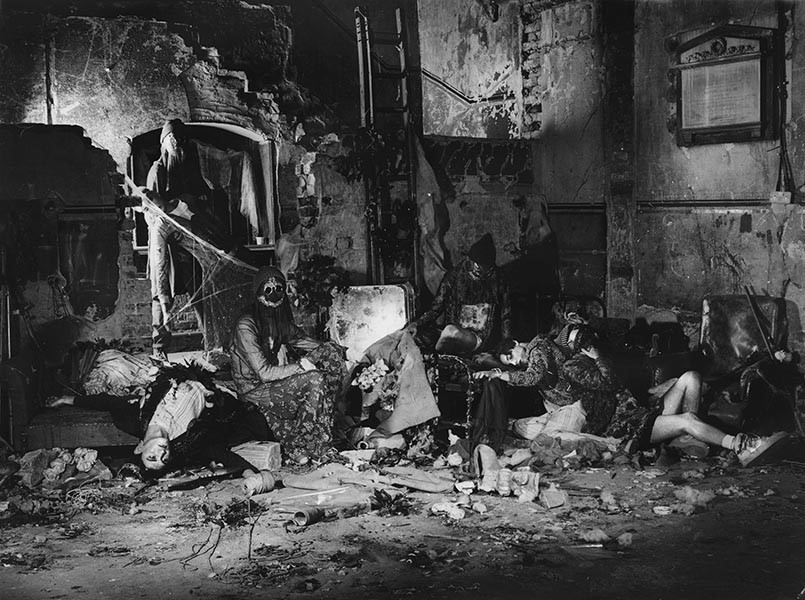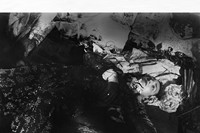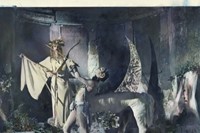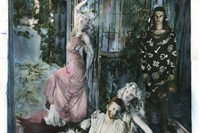Paulina Otylie Surys is a fashion photographer with a unique practice. Having trained in classical painting, she made a decision to take up screen printing around two years ago and through that "found [her] way towards photography"...
Paulina Otylie Surys is a fashion photographer with a unique practice. Having trained in classical painting, she made a decision to take up screen printing around two years ago and through that "found [her] way towards photography." Using innovative combinations of toners and inks over dry dyes, on silver gelatin fibre paper, Surys creates haunting, pseudo-gothic works embued with a heightened sense of drama and compostition. This approach works in perfect juxtapostion to the modern clothing and appearance of her models – as demonstrated in her striking photographs of the Meadham Kirchoff S/S13 collection for the new issue of Another Man, styled by Ellie Grace Cumming.
In celebration of the issue's release, and to coincide with an exhibition of Surys work at the Richard Young Gallery, we speak to Surys and uncover more about her inspirations and working methods.
Having trained primarily in classical painting, when and why did you decide to turn your hand to fashion photography?
I started making photographs about two years ago after a long period of working as a painter. I began by taking a few Polaroids and painted them in order to use them for screen printing. I never returned to screen printing or traditional painting, though what I do is quite painterly. The fashion angle is not something I had pre-imagined, but I am thankful that the reception as been good. Three years ago, I may not have envisioned myself as photographer, let alone a fashion photographer.
You embrace classical influences and more traditional methods of practice, and yet you achieve an interesting modernity on your work. How do you strike a balance between new and old?
The balance is perhaps due in measure to the different facets of pictorial tradition I am interested in and a loose aesthetic of decay, which is also informative of the classical tradition. I think photography offers several possibilities for this tradition, but should also be understood as a modern tool for projecting these balances. Somehow it happens between an elegiac vision of what I want and the way the medium handles my initiatives.
"I think photography offers several possibilities for the classical tradition, but should also be understood as a modern tool for projecting these balances"
Composition is very important to your work. Do you have a favourite painter or photographer whose compositional approach you particularly admire?
Henri Matisse, his composition and colour, also Jackson Pollock – his technique of layering the paint on canvas, but also the conduit between his psyche and the work. I'm relating here to a sort of transcendence evoked by the simple gesture of applying colour on canvas, in my case, layering oils and tars on photographic paper. It's instinctive, comes deep from within subconsciousness. The transcendent, intuitive state of mind is also present during the shoot and creating the set design.
What do you hope your photographs inspire in those that view them?
I'm not looking for inspiration. It's more about the effect still images have on a viewer. I'm interested in how a viewer interprets the moments before and after the frame they are presented with. Perhaps I am interested to know if the margins can be understood or if the work leads to a further investigation process.
How important is a sense of narrative in your work?
I'm interested in narrative in so much as I want to create a loose narrative, in anachronistic terms, that doesn't really grapple with current realities, but perhaps evokes the history and various traditions of photographic medium.
What’s the best creative advice you’ve been given?
I agree with the advice that you must know the tradition of a medium in order to make its inverse happen in the image. A breaking of tradition, even a mistake, can enable the possibility of a new language within the image. This membrane is that which competes with the familiarity of what we perceive our knowledge of these systems of imagery to be.
Can you talk us through your thought process behind the shoot for Another Man? What were your key inspirations?
My process is much about what I myself encounter when searching for references that i use in my work. I am looking at photography, the history of art, and fashion amongst the general inspiration I derive from the working process itself.
Paulina Otylie Surys: The Garden of Earthly Delights is at the Richard Young Gallery until April 27
Text by Daisy Woodward



